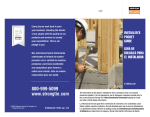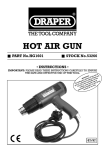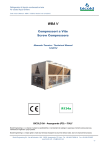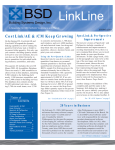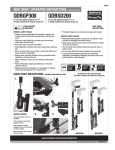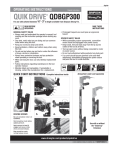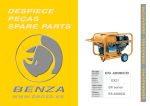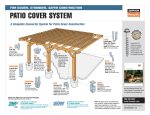Download Simpson Strong-Tie TSBR2-24 Instructions / Assembly
Transcript
BUILDERS Wood Truss Restraint and Bracing Guide Using Simpson Strong‑Tie ® Products To Meet the Recommendations of the Building Component Safet y Information (BCSI) Guide ( 800 ) 999-5099 | www.strongtie.com Wood Truss Restraint and Bracing Guide Touch It Once – You’re Done Positioning and bracing trusses during installation can be a time-consuming process that can drive up labor costs on the project. After all the bracing is measured, cut and installed, it will ultimately be pulled off before the roof sheathing goes on. Not only does this tedious installation and removal create additional labor expenses, it also costs money to collect and dispose of the wood bracing material left on the jobsite. More importantly, there are safety concerns when sheathing crews are forced to work on top of non-braced trusses. With Simpson Strong-Tie® restraint and bracing products, installing bracing is faster and easier, and since they stay on the trusses permanently, installers touch them once and walk away. No need to come back to remove them, no wasted lumber – removal and disposal costs are eliminated. In addition, since they stay in place, sheathing crews are able to work on braced trusses that are more stable. With Simpson Strong-Tie restraint and bracing products, crews work faster and safer. TSBR: Efficiency in Spacing and Restraint W 19/16 " L 1 /1 TSBR2-24 9 6 U.S. Patent 6,993,882 (TSBR2-16 similar) " D TSBR Truss Spacer Restraint – The Most Efficient Way to Satisfy BCSI Recommendations • TSBR captures the trusses at exact on-center spacing without measuring or cutting • Easily “grabs” onto the truss – can be put in place with one hand • Minimum nailing option for even faster installation • Installs without prongs or sharp edges, which are potential safety hazards • Stays in place during sheathing, saving time and making the roof more stable for workers • Boxed tubular shape for safety and strength in tension and compression TSBR lateral spacer restraint TBD22 diagonal brace Dimensions (in.) L W D Fasteners (Total) TSBR2-162 (Min.) 17 1⁄2 1 1⁄4 1 1⁄4 TSBR2-16 (Max.) 17 1⁄2 1 1⁄4 1 1⁄4 TSBR2-242 (Min.) 25 1⁄2 1 3⁄4 1 (2) 10d TSBR2-24 (Max.) 25 ⁄2 1 3⁄4 1 (4) 10dx1 1⁄2" Model No. 1 Allowable Loads (lbs.) DF/SP SPF/HF Compression Tension Compression (2) 10d 540 180 465 Tension 155 (4) 10dx1 1⁄2" 540 455 465 390 500 180 430 155 500 455 430 390 1. No load duration increase allowed. 2. Minimum nailing meets or exceeds the temporary lateral restraint recommendations of WTCA/TPI BCSI-08. 3. Nails: 10dx1 1⁄2 = 0.148" dia. x 1 1⁄2" long, 10d = 0.148" dia. x 3" long. ©2011 Simpson Strong-Tie Company Inc. F-TSBRTBD2211 3/11 exp. 12/31/14 Wood Truss Restraint and Bracing Guide How to Satisfy BCSI Temporary Restraint and Industry-standard guidelines for the safe erection and installation of wood trusses are published in the Building Component Safety Information: Guide to Good Practice for Handling, Installing, Restraining & Bracing of Metal Plate Connected Wood Trusses (BCSI). The BCSI guide is published jointly by the Structural Building Components Association (SBCA), its Wood Truss Council and the Truss Plate Institute (TPI). This document is intended to show the proper application of Simpson Strong‑Tie lateral restraint (TSBR) and diagonal bracing (TBD22) products when used in conjunction with the BCSI recommendations for restraining and bracing the top chord, bottom chord and web planes of the trusses. It is not intended to replace the BCSI or its Summary Sheets. See BCSI B1 and B2 for ground bracing recommendations. Top-Chord Temporary Lateral Restraint and Bracing with Simpson Strong-Tie TSBR and TBD22 Image courtesy of SBCA Excerpts from BCSI – 08 Lateral stability of truss systems is typically comprised of two components: • Continuous Lateral Restraint • Diagonal Bracing Lateral Restraint: also known as Continuous Lateral Brace (Restraint): A line of structural members installed at right angles to a chord or web member of a truss to reduce the laterally unsupported length of the truss member. For top-chord temporary lateral restraint, TSBR must be installed at each pitch break (change in chord direction) and may not exceed the on-center spacing shown in the table below (from BCSI). Only one row of TSBRs is required at the peak of the trusses; there is no need to install TSBRs on both sides. Additionally, if the height of the truss over the exterior supporting structure is more than 10", install an additional row of TSBRs at this location. Maximum Spacing of TSBR Spacer Restraints on Top Chord (per BCSI Table B2-1) Overall Truss Length 1 Up to 30' 30'– 45' 45'–60' 60'–80' 2 1. The Overall Truss Length refers to the overall length of the truss including cantilevers, exclusive of overhangs. 2. BCSI recommends consulting with a Registered Design Professional for erection restraint and bracing assistance for truss lengths greater than 60'. (IBC [2009] Section 2303.4.1.3 requires the Registered Design Professional to do the design for the temporary installation restraint and bracing and the permanent individual truss member restraint and bracing for trusses with clear spans of 60' or greater.) * = *Pitch break p Diagonal Bracing: A structural member installed at an angle (approx. 45o) to a truss chord or web member and intended to temporarily and/or permanently stabilize truss members and/or trusses. 5'-6" * d a row TS Under 8' * The continuous lateral restraint forces the connected truss members to move in the same direction. Maximum Spacing 10' on-center 8' on-center 6' on-center 4' on-center Over 8' (add a row of TSBR) * 5'-6" * 5'-6" 8'-10" 3'-4" * 4'-4" 33'-0" Span Example of TSBR placement on top chord of truss with multiple pitch breaks. TSBR captures exact O.C. spacing TSBR spacer restraint 10" or greater over wall height Truss attachment required at support(s) Diagonal Bracing provides stability by resisting the domino effect of connected trusses. See BCSI B1 and B2 for ground bracing recommendations Wood blocking at odd spacings tTSBR for top chord lateral restraint ©2011 Simpson Strong-Tie Company Inc. F-TSBRTBD2211 3/11 exp. 12/31/14 Bracing Recommendations Use TBD22 for diagonal bracing. TBD22 must be installed immediately after the first five trusses are erected, and then after every 10 trusses are set as well as at the end of the truss run. 7 6 5 4 3 AHEP (See back page) TSBR spacing between rows is based on overall truss length 60' TSBR Edge Nail 4' T20 T19 T20 1 TSBR T2 Face Nail TBD22 T19 Typical TBD22 Top Chord Installation with Minimum Nailing T27 T26 T25 T18 T29 T28 T37 T22 T41 46' TBD22 for top-chord diagonal bracing Diagonally brace bottom chord and web planes at the same locations as top chord diagonal bracing T42 T43 T44 Bottom Chord Lateral Restraint and Bracing with the TSBR and TBD22 W T17 T16 T15 T24 T2 1 T19 1 T19 T19 32' TSBRs W Wood blocking AHEPs (see back page) Truss top chords and webs not shown for clarity Runs of TBD22 ©2011 Simpson Strong-Tie Company Inc. F-TSBRTBD2211 3/11 exp. 12/31/14 T20 T20 T22 T19 T20 T20 TBD22 diagonal bracing must be installed on the bottom chords at the same intervals as the top chord diagonal bracing. T31 W T2 Use TSBR for both temporary and permanent bottom chord lateral restraint. Bottom chords must be laterally restrained during installation at 15' o.c. or less until the ceiling is installed. If there is no ceiling directly attached to the bottom chords, install rows of TSBR during truss placement at the on-center spacing specified on the Truss Design Drawing (TDD) or by the building Designer (10' o.c. max). This will simultaneously satisfy both temporary and permanent restraint requirements. T45 Adding Lateral Restraints and Diagonal Bracing to the Truss Placement Diagram Once the on-center spacing of the lateral restraints is determined from BCSI Table B2-1, locating the runs of TSBRs on the Truss Placement Diagram (TPD), typically provided by the component manufacturer, is easy for each of the different truss types, as shown below. Once the TSBRs have been located, the locations of the required diagonal bracing (TBD22) can easily be added, starting with the first five trusses in the run and then every ten (10) truss spaces thereafter. Each truss run terminates with a set of diagonal braces as indicated below. Having the restraint and bracing locations clearly delineated will assist in getting all members of the erection crew familiar with the intended erection plan. 28' 1¼" ened t Flat W T8 W W TBD22 Typical W " 1/ L 9 16 D T6 3¹⁄₂" VTCR (See back page) W W 0 11 9 7 ON ® PS e S Mong-T St 50' T7 T35 T33 9 6 46' T39 T34 T32 1 /1 Typical T38 T40 T30 TSBR2-24 5 3 12 10 8 6 4 2 1 2" " 2¹⁄₂ GBC W (See back page) 4' 16' 12' 28' 88' Typical Truss Placement Diagram Showing Locations for Truss Installation/Erection Lateral Restraints and Diagonal Bracing The TPD often identifies other products such as truss-to-plate tiedowns, truss-to-truss connectors, etc. While these have been left off the TPD above for the purpose of clarity, the following other products are included on the TPD above: the VTCRs (for connecting the valley trusses), AHEPs (adjustable hip-end purlins for step down hip systems), and GBCs (gable end brace connectors). Please see the back page of this flier for information about these products. NOTICE: Proper truss erection, installation, restraint and bracing requires an understanding of triangulation within, and between, the various planes of the truss (i.e., top chord, bottom chord and web). It is critical to note that all rows of Simpson Strong-Tie® TSBR, installed for lateral restraint, must be diagonally braced with TBD22 bracing installed in an ‘X’ pattern. TSBR spacer restraints alone are not adequate to resist the buckling and overturning forces in the members to which they are attached without the rigidity provided by the TBD22 diagonal bracing spaced as indicated. ©2011 Simpson Strong-Tie Company Inc. F-TSBRTBD2211 3/11 exp. 12/31/14 " Web Lateral Restraint and Bracing with the TSBR and TBD22 The TSBR spacer restraint is ideal for permanent web member lateral restraint requirements because it is easier to install than long wood braces which need to be overlapped over two trusses at each end. Install the TSBR wherever the Truss Design Drawing indicates continuous lateral web restraint is required. TBD22 diagonal bracing must be installed on the web members along the row of TSBRs every 20' and at each end of the run of similar trusses. Note: If no web members require TSBR spacerrestraint, install TBD22 diagonal bracing during truss installation on the web members in line with the bottom chord TSBRs and at the same intervals as the top-chord and The Truss Design Drawing will indicate required bottom-chord diagonal bracing. locations for lateral restraint on web members. Bracing of Piggybacks TSBR and TBD22 offer an effective means to permanently laterally restrain and brace piggyback assemblies consisting of a supporting “base” truss and a supported “cap” truss that is set directly on top of the base truss. Both the TSBR and TBD22 lie flat in the top chord plane of the base truss, eliminating the need to raise the bottom chords of the cap trusses, such as is necessary when purlins and diagonal bracing are used. The figure below illustrates the use of TSBR and TBD22 to permanently laterally restrain and brace the flat top chord section of the base trusses prior to the installation of the cap trusses. In this case, the TSBRs are installed at the top chord purlin spacing indicated on the Truss Design Drawing, and the TBD22 diagonal bracing is installed at 10' intervals or as otherwise required by the Designer (reference BCSI-B3). Supported (“Cap”) Frames TSBR spacer restraint TBD22 diagonal bracing Excerpts from BCSI – 08 (Cont.) Section B2 contains the following statement: Proper truss erection, installation, restraint and bracing require an understanding of triangulation within and between the various planes of the truss (i.e., top chord, bottom chord and web). It is critical to note that all lateral restraints must be braced. Lateral restraint by itself is not adequate to resist the buckling forces in the members to which it is attached without the rigidity provided by bracing. Bracing is typically provided by adding diagonal bracing within the same plane of the lateral restraint. Top-Chord Plane Lateral Restraint Spacing From BCSI table B2-1, the maximum on-center locations for top chord temporary lateral restraints are determined by the overall truss length and the length of the top chord between pitch breaks (i.e., change of slope). Ground bracing is then placed in line with the required locations of the rows of lateral restraints. Web Member Plane Lateral Restraint and Diagonal Bracing Spacing The Truss Design Drawing will specify the webs (if any) requiring permanent lateral restraint and how many restraints are needed (1 or 2 generally). The web Diagonal Braces, acting together with the Top Chord and Bottom Chord Temporary Lateral Restraints, form triangulation perpendicular to the plane of the trusses, thus creating additional lateral stability for the trusses. Diagonal Bracing installed for the purpose of increasing the stability of the truss system during installation shall be installed on web members (verticals whenever possible), located at or near each row of Bottom Chord Lateral Restraints. Diagonal Braces are required at each end of a Truss row and repeated every 10 Truss spaces (20' maximum). Bottom-Chord Plane Lateral Restraint Spacing BCSI recommends the following spacings for lateral restraint of the bottom chord plane, based upon whether the restraint will be part of the temporary bracing or permanent bracing system: • For temporary bracing systems the lateral restraint rows must not be over 15' on-center. • For the permanent bracing system, the lateral restraint rows should be spaced as specified on the construction documents or the Truss Design Drawing, not to exceed 10' on-center. Base trusses (bracing not shown for clarity) Excerpt from IBC 2009 During the installation of the base trusses (and then the supported cap frames), the top chord, bottom chord and web members must be temporarily laterally restrained and braced until all of the permanent bracing is in place. This is accomplished the same as all other trusses – refer to the respective sections of this document for information regarding top chord, bottom chord and web lateral restraint and diagonal bracing with the TSBR and TBD22. ©2011 Simpson Strong-Tie Company Inc. F-TSBRTBD2211 3/11 exp. 12/31/14 2303.4.1.3 Trusses spanning 60 feet or greater. The owner shall contract with any qualified registered design professional for the design of the temporary installation restraint/bracing and the permanent individual truss member restraint/bracing for all trusses with clear spans [sic] 60 feet (18 288 mm) or greater. Wood Truss Restraint and Bracing Guide TBD22: Save Time – Right Out of The Box The TBD22 diagonal truss brace offers a time-saving substitute for wood diagonal bracing that helps satisfy the prescriptive recommendations of WTCA/TPI BCSI when used with the TSBR spacer restraint. When installed on the top and bottom chords, as well as the web planes, the TBD captures the forces generated by the TSBR and transfers them diagonally to the edge of the braced-truss system. For ease of handling, the TBD travels in a box like a flat strap, and is formed into an ‘A’ shape as it is pulled from the carton to provide rigidity and prevent sagging between trusses during installation. As it is fastened to the trusses the brace flattens, allowing sheathing to be installed right over it and saving the time typically needed to remove wood bracing. This also creates a safer work environment since the brace stays in place while sheathing is installed. 1¼" ened t Flat The TBD22 Diagonal Brace: • Helps satisfy prescriptive temporary bracing recommendations of the WTCA/TPI BCSI • Rigid A-shape design virtually eliminates sagging between trusses spaced 16"–24" on center TBD22 US Patent Pending • Saves the time needed to remove diagonal bracing before sheathing • Eliminates the dangerous practice of removing bracing prior to sheathing • Has a dimpled nailing grid which allows installation with standard pneumatic fasteners • 160' of bracing in an easy-to-handle carton Installation: • Use all specified fasteners; see the General Notes section of our Wood Construction Connectors catalog for more information. • Strap does not have holes for fasteners. Nails shall be installed in the dimpled areas and placed to maintain a minimum of 1⁄4" strap edge distance and a minimum of 1⁄2" center-to-center distance. Nails should be installed in the center of the lumber narrow face and with a minimum edge distance of 1" on the lumber wide face. The TBD22 is formed into an ‘A’ shape as it is pulled from the box TSBR spacer restraint TBD22 diagonal bracing • TBD22 braces span diagonally at approximately 45° in an X-configuration. • Strap shall not be slack, but tight and ready to engage in tension. • At the end of the TBD22 braces trusses shall be laterally restrained to resist out of plane forces. • Bracing locations shown in the drawing are recommendations for temporary bracing only. Installation of TBD22 braces for permanent lateral bracing shall be per the Designer. Allowable Loads for TBD22 Diagonal-Bracing Strap Fasteners Model No. Allowable Tension Loads 1 Strap Ends Intermediate Trusses DF/SP SPF/HF TBD22 (Min.) Face: (1) 10dx1 ½" Edge: (1) 10dx1 ½" (1) 10dx1 ½" 430 390 TBD22 (Max.) Face: (2) 10dx1 ½" Edge: (1) 10dx1 ½" (1) 10dx1 ½" 565 520 1. 2. 3. 4. Allowable loads have been increased for construction and wind loading with no further increase allowed. Minimum nailing loads meet or exceed the WTCA/TPI BCSI-08 recommendations. TBD22 straps must always be installed in an ‘X’ pattern, taut and ready to engage in tension. Nails: 10dx1 ½" = 0.148 dia. x 1 ½" long. ©2011 Simpson Strong-Tie Company Inc. F-TSBRTBD2211 3/11 exp. 12/31/14 Wood Truss Restraint and Bracing Guide Additional Truss Placement Solutions Simpson Strong-Tie manufactures literally thousands of connector products for light frame construction. We offer the largest selection of lab and field tested connectors, along with the dedicated engineers and field support reps to back them up. You can count on our products and our people to perform. Below are three innovative products that provide engineered solutions to specific bracing or connection needs of the truss placement example depicted within this bulletin. Single-Sided Valley Truss Clip (VTCR) The VTCR is a single-sided valley truss clip that provides a positive connection between the valley truss and the supporting framing below. Installed on top of the roof sheathing, it eliminates the need to add a support wedge under the valley truss or to bevel the bottom chord to match the roof pitch. The connector’s front-face installation contributes to its ease of installation, and it installs with nails or with Simpson Strong-Tie® Strong-Drive® SD structural-connector screws, the latter resulting in a nearly 30% increase in uplift capacity. 7 6 5 4 3 Adjustable Hip-End Purlin (AHEP) for Wood and Cold-Formed Steel Truss Construction This innovative, patent-pending product serves as an installation aid for step-down hip trusses by accurately spacing and laterally restraining the flat section of the top chords. Additionally, the AHEP can remain in place and function as a structural purlin for the hip-end system. With its interlocking design that allows for linear installation, the AHEP can be installed in line with the end jack trusses to maintain framing alignment from eave to hip or peak. Gable End Truss Gable Brace Connector (GBC) The Simpson Strong-Tie GBC is specifically designed for the tension and compression requirements of the gable brace connection. The GBC provides improved anchorage of the diagonal brace to the top of the gable end wall using a minimum 2x4 stress-graded lumber. The GBC is rated for diagonal brace angles from 40° to 60°. ® Wall Top Plate 2" min. Gable Brace Gable Brace Flush at Inside Edge of Plates For more information about these and other Simpson Strong-Tie connector products, please reference our latest Wood Construction Connectors catalog, or visit our website at www.strongtie.com. This flier is effective until June 30, 2013, and reflects information available as of March 1, 2011. This information is updated periodically and should not be relied upon after June 30, 2013; contact Simpson Strong‑Tie for current information and limited warranty or see www.strongtie.com. ©2011 Simpson Strong-Tie Company Inc. • P.O. Box 10789, Pleasanton, CA 94588 F-TSBRTBD2211 3/11 exp. 12/31/14 800-999-5099 www.strongtie.com








